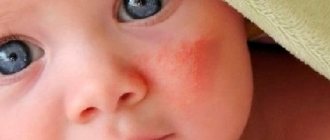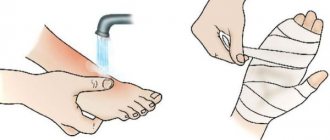Features of lactostasis
Lactostasis is the stagnation of milk in the milk ducts. It is formed when one or more milk ducts are blocked. In the part of the mammary gland where stagnation has occurred, a thickening is felt, which gradually becomes more and more painful due to the developing inflammatory process. Untimely treatment of lactostasis can lead to the spread of the inflammatory process throughout the mammary gland and its transition to inflammation of the mammary gland - mastitis. The initial stage of mastitis is characterized by swelling and tenderness of the mammary gland and an increase in body temperature. At this stage, it is necessary to urgently consult a mammologist. Further, under the influence of staphylococci, streptococci and other pathogens, suppuration develops and purulent abscesses appear. This stage is called purulent mastitis and most often requires surgical intervention - opening of purulent abscesses.
Ideally, it is better to consult a mammologist or breastfeeding specialist before any problems arise. No articles on the Internet will give the same understanding of actions during breastfeeding and self-confidence as if the doctor once shows what, how and when to do correctly.
Breastfeeding Center
Treatment of lactostasis.
Treatment of lactation mastitis.
Treatment of trace galactorrhea (continuous lactation discharge after breastfeeding ends).
The period of feeding a child is a very important time, both for the woman and for the child himself. At the moment, the child receives the necessary attention from the mother, develops emotionally, and also receives the immunity necessary for him. At the same time, the mother receives positive emotions (at the time of feeding the child, the body produces hormones of happiness), in the first six months of feeding, new malignant tumors cannot form in the mammary gland, and in the next 6 months, physiological changes occur in the mammary gland, during which they may disappear benign, non-tumor diseases of the mammary glands (diffuse mastopathy) formed before pregnancy. However, during this period, inflammatory diseases such as lactostasis and lactation mastitis .
!If you have stagnation of milk (a painful lump in the mammary gland appears, redness of the skin over the lump, a local increase in temperature in this area, increased body temperature, soreness), try to follow the following recommendations:
- Start feeding from the breast where the lump appears. Feeding or expressing milk should be done fully every 2-3 hours;
- To facilitate pumping or feeding, the outflow of milk before feeding, take a warm shower, or apply a warm heating pad for 10 minutes on the mammary gland, area of stagnation of milk, nipple;
- To ensure uniform outflow of milk from all parts of the mammary gland, it is recommended to perform a massage using gentle circular movements from the periphery to the center;
- After feeding, there should be no lumps left in the mammary gland;
!!We do not recommend:
- Apply honey, apply cabbage
- Treatment of lactostasis with ultrasound should be abandoned, since despite the good initial results of this technique, a complication such as purulent inflammation may subsequently arise - acute lactation mastitis, the treatment of which will require surgical intervention.
- Seek help from a lactation consultant. Remember that a lactation consultant is not a doctor and does not have a medical degree or ambulatory care certification. Therefore, cannot be held responsible for the prescribed treatment. Of course, a consultant can help you with advice on how to properly latch on to your baby and how to establish breastfeeding, but not to treat inflammation or prescribe medications.
- Steam your breasts with a broom in a bathhouse
- Intensively kneading and massaging the breasts can lead to even greater swelling of the mammary gland.
!!!If signs of inflammation of the mammary glands do not go away within 24 hours, come to an appointment with a mammologist.
Why does lactostasis occur?
- Limiting the baby's presence at the breast. It should be understood that each baby needs a certain time to get enough. Not all babies can do this quickly.
- Failure to follow the rules of pumping and improper breastfeeding.
- Compressing the breast with your hands.
- Rare feedings. You should properly organize your baby’s nutrition. This will eliminate the problem of glands overflowing with milk. Do not think that a child must be very hungry in order to eat well. The baby will drink as much as he can. Excess milk will simply linger in the ducts and provoke lactostasis.
- Incorrect position of the baby and mother during feeding.
- Premature introduction of artificial formulas into the baby’s diet. The child may refuse milk. This will also lead to stagnation and lactostasis.
- Uncomfortable, tight underwear. You can't refuse to wear a bra. The breasts will fill with milk faster.
- The habit of sleeping on your stomach.
- Stress. Any negative emotions can lead to a violation of milk production standards.
Important! Lactostasis is not a disease. However, it can negatively affect the health of the young mother.
Self-prevention and elimination of lactostasis
- Regular feeding of the baby on demand helps to empty the mammary ducts evenly and allows the body to adjust milk production to the needs of the baby.
- It is advisable to change the position of the baby when feeding in order to use different lobes of the mammary glands and avoid emptying only some lobes and stagnation of milk in others.
- It is better to avoid excessive pumping, as the body will perceive it as an increase in the need for milk and will begin to produce more than necessary, which will lead to a relapse of lactostasis.
- If a lump appears, especially painful, in any part of the breast, if the child cannot “dissolve” it, you need to carefully dissolve such stagnation under a warm shower or using a breast pump.
- If you cannot resolve such a lump on your own, you need to seek help from a mammologist.
Important! The mammary gland must be handled carefully: improper handling can contribute to bruising, increased swelling, the spread of inflammatory processes, etc. Therefore, if you cannot eliminate lactostasis on your own, you should not apply persistence and force: this can seriously harm and cause diseases that require serious treatment.
Why is ultrasound recommended?
Expressing lactostasis with ultrasound is an effective and safe procedure, thanks to which you can quickly stop the development of the inflammatory process in the breast, soften lumps, improve the flow of milk and make the nursing mother feel better. In the absence of contraindications, UT or ultrasound therapy for lactostasis has the following advantages:
- improving blood supply to tissues in the area of stagnation;
- elimination of pain;
- removal of swelling;
- stopping the inflammatory process and preventing its further development;
- relief from spasms.
Need to know! The effect of ultrasonic waves with a frequency of 20-3000 kHz on the mammary glands is also considered bactericidal, restorative and relaxing; it does not damage the breast, at the same time massages and warms the tissue by 1°C. The ultrasonic wave breaks up the seal, and the body responds to an increase in temperature by improving metabolism.
As a result, the patient quickly and painlessly receives three types of treatment at once - mechanical, thermal and physico-chemical. At the same time, the restoration function is launched at the cellular level, ensuring the removal of swelling, resorption of compactions, elimination of pain and stagnation in the ducts of the mammary glands.
Elimination of lactostasis and mastitis by a mammologist
- Treatment of lactostasis by a doctor occurs under the control of an ultrasonic sensor. The doctor sees the source of the problem and knows how to solve it as efficiently as possible, painlessly and without complications.
- The doctor performs an examination, ultrasound of the mammary glands, makes a diagnosis and prescribes treatment. Depending on the situation, treatment can be non-drug, medicinal, physiotherapeutic, and in serious, advanced cases, the doctor may decide on the need for surgical intervention. It is very important to understand that only a mammologist knows all the indications and contraindications for various types of therapy and can prescribe the correct treatment. There are now many breastfeeding services where specially trained nurses make home visits. Unfortunately, nurses are good at only “decanting”, but in some cases this may not be enough or, conversely, contraindicated. For example, with mastitis, it is very important to determine whether there are purulent abscesses. Self-medication and attempts to “dissolve” such abscesses lead to very sad consequences. It is also dangerous that with purulent mastitis, despite the presence of purulent cavities (abscesses), the body temperature can be normal, and this is often perceived by the “self-medicating” patient as an improvement in the condition and a tendency to recovery.
- The doctor is a breastfeeding specialist and will be able to give personal recommendations to each patient that are suitable for her.
ultrasound for lactostasis
The birth of a baby is a MIRACLE. And breastfeeding was a priority for me. But everything turned out to be not so simple...
I really don’t want to repeat the mistakes I made during breastfeeding with my second baby. Therefore, I am studying the issues of establishing breastfeeding after a cesarean section.
, I consult online with breastfeeding specialists, save contact information, and mark interesting tips. We also plan to attend courses on breastfeeding by N. Razakhatskaya. For some reason I didn’t get to them during my last pregnancy, but I studied Razakhatskaya’s book inside and out. And it still didn’t work out for me...
From 1 month we were already completely on IV. There are huge difficulties with GW...
Cracked nipples from the maternity hospital. I controlled the attachment (I covered the entire areola), but I always fed in one position - in another my son simply did not latch onto the breast. By three weeks we were completely breastfeeding, but after feeding the baby always cried (not enough milk?). Because of my cracks , feeding was very painful. No ointments helped.
The baby’s mouth was open exactly as in the picture, I kept an eye on it. Even the mucous membrane of the sponges was visible, he tried so hard... His cheeks were puffed up, he was swallowing milk, his nose and chin were pressed to his chest... Everything was like in the book. But the pain did not go away, although everyone promised that it would get easier...
On the 21st day, lactostasis formed - a temperature of up to 39 in the armpit and elbow (I believe that due to missing night feedings - the child slept all night, I did not hear the alarm clock for feeding). I was prescribed pumping 2 times a day with a midwife in the hospital (terribly painful), ultrasound and an antibiotic (compatible with breastfeeding). I applied the baby, but the lump did not go away for 7 days, feeding was painful due to cracked nipples.
After a week of suffering, the child and I ended up in hospital No. 3 (department for postpartum complications, where you can stay with the baby). They performed a puncture , there was no pus (the diagnosis was infiltrative mastitis ), although they found a large amount of Staphylococcus aureus I continued to express about 60 ml of milk every three hours while the AB was dripping. After a course of intravenous AB, the doctor decided to stop lactation , citing the fact that there was little milk and many problems, and also said that the infiltrate would not go away as long as there was milk in the ducts. As a result, I was prescribed bromocriptine for 14 days and discharged.
I SHOULD have maintained the GW , but I turned out to be weak.
The question is: what is my main mistake ?
(I highlight the following: improper attachment, failure to contact a breastfeeding consultant from the first days at home, use of bottles for formula feeding and nipples in the maternity hospital, skipping one night feeding, excessive fluid intake - more than 3 liters, possible infection due to cracked nipples)
How to avoid painful feeding and recurrence of the situation?
I have very small and flat nipples , could this cause the baby to not attach correctly?
Breastfeeding a child is my unfulfilled DREAM ! But I will make every effort to ensure that the second baby receives mother’s milk. What we experienced with our son on formula is scary to write... terrible atopic dermatitis, which he outgrew only after 2 years. Allergy to cow protein. After 1.5 years we switched to goat milk. Before this it was sprinkled on any mixture. How much money, tears, nerves, torment....
Treatment of lactostasis in
At CityClinic, consultations regarding lactostasis and mastitis are conducted by a mammologist of the highest category, ultrasound diagnostics doctor, breastfeeding specialist Zemfira Kazimirovna Bogova.
An experienced specialist is always ready to help every young mother. The doctor will give competent recommendations, if necessary, prescribe a comprehensive diagnosis, make a diagnosis and determine a treatment program.
You will not overpay for the services of a professional. Prices for appointments and consultations are optimal for all our clients.
Contact us!










